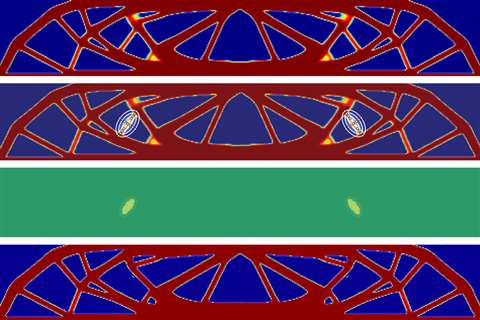AI can design key building elements - but needs a human’s watchful eye
03 March 2023
Artificial intelligence systems can design building elements automatically but intervention from human specialists makes optimisation of that design more effective.
 MIT said that human intervention in AI design of building elements resulted in better results than fully automated design (Image courtesy of MIT)
MIT said that human intervention in AI design of building elements resulted in better results than fully automated design (Image courtesy of MIT)
That’s the conclusion of researchers at the Massachusetts Institute of Technology (MIT) in the US, who have found a way to achieve the best of both in these approaches.
MIT said that new generative design systems that can be used to create innovative designs for all sorts of things, including parts of a new building. But they often fall short of producing designs fully optimised for their purpose.
For example, designs may not provide the greatest strength in proportion to weight, or minimising the amount of material needed to support a given load.
But MIT doctoral student Dat Ha and assistant professor of civil and environmental engineering Josephine Carstensen found that using an automated system and stopping the process periodically to allow human engineers to evaluate the work in progress resulted in better designs than from an automated system alone. The process was also quicker than a fully manual approach.
They hope that the new approach can apply to a broad range of scales and applications. That includes the design of everything from the structural support members of a skyscraper, to nanoscale materials.
Human intervention
As a demonstration of the process in action, the researchers designed a number of structural load-bearing beams of the type that might be used in a building or bridge.
In their iterations, they saw that the design had an area that could fail prematurely. They selected that feature and asked the computer’s AI to address it. The computer revised the design, removed the highlighted strut, and strengthened other struts to compensate, leading to an improved final design.
The process, which they call ‘Human-Informed Topology Optimisation’, starts by setting out the specifications a building element needs. For example, it might determine how long a beam needs to be, where it is supported and how much load it needs to carry.
Carstensen said that the result may not be as ideal as what a rigorous but slower design algorithm that considers the underlying physics could produce. But it still delivers a result better than one generated by a rapid automated design system alone.
“What we can show is that instead of using several hours to get something, we can use 10 minutes and get something much better than where we started off,” she added.
The system can be used to optimise a design based on any desired properties, not just strength and weight, MIT claimed. For example, it can be used to minimize fracture or buckling, or to reduce stresses in the material by softening corners.
Carstensen said: “As we’re seeing the structure evolve on the computer screen in response to initial specification, we interrupt the design and ask the user to judge it. The user can say, ‘I am not a fan of this region, I’d like you to beef it up or beef down this feature size requirement.’ And then the algorithm takes into account the user input.”
The automotive and aerospace industries have already been using automated design systems over the past decade, where reducing weight while maintaining structural strength is key. Ha said of the process MIT has researched, “It’s a way to take advantage of how we can make things in much more complex ways than we could in the past.”
‘Extraordinary potential’
Commenting on the research, Christian Málaga-Chuquitaype, a professor of civil and environmental engineering at Imperial College London, who was not associated with this work, said, “The potential applications of Prof Carstensen’s research and tools are quite extraordinary.
“With this work, her group is paving the way toward a truly synergistic human-machine design interaction.”
He added, “By integrating engineering ‘intuition’ (or engineering ‘judgement’) into a rigorous yet computationally efficient topology optimization process, the human engineer is offered the possibility of guiding the creation of optimal structural configurations in a way that was not available to us before. Her findings have the potential to change the way engineers tackle ‘day-to-day’ design tasks.”
Carstensen and Ha’s results have been reported in the journal Structural and Multidisciplinary Optimization.
STAY CONNECTED



Receive the information you need when you need it through our world-leading magazines, newsletters and daily briefings.
CONNECT WITH THE TEAM








